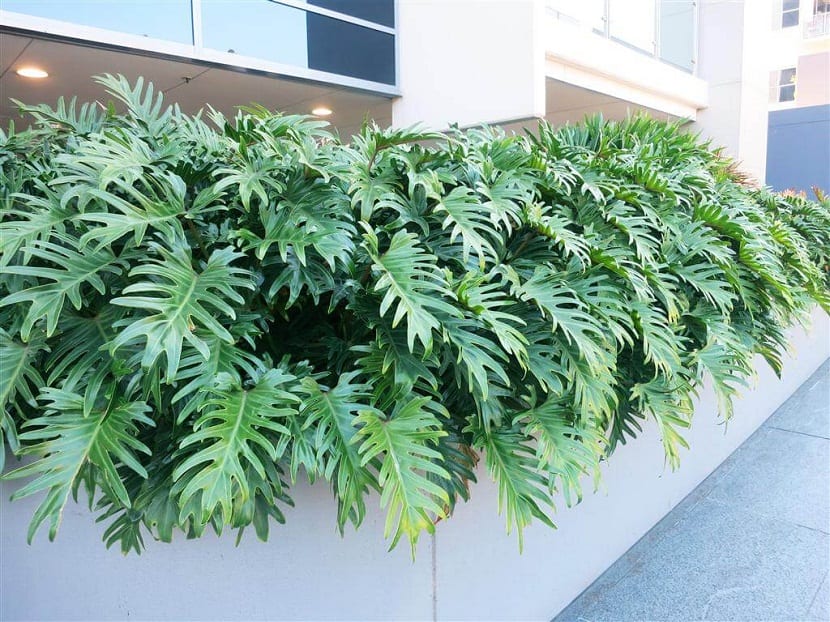
The Philodendron xanadu or simply philodendron it is a perennial species of the Areceae family Much admired for its beautiful foliage, it is an easy-to-grow plant whose green leafiness captivates by its splendor and unlike other species of the family that are climbers, this is a vertical plant, ideal for small spaces
This plant is native to South America, more specifically from Brazil and Paraguay, where it grows naturally in its tropical forests.
Features

The main feature of this philodendron variety They are your big green leaves, as well as its erect position from whose center the leaves emerge. It is an extraordinary plant with tropical foliage, with segmented and frequently drooping, oval and lobed leaves, of a bright green hue with a number of lobes ranging from 15 to 20.
The leaves emerge from the base and unfold attached to it through long peduncles. Its lush leaves they can reach up to 40 cm long by 25 cm wide, blooming in long and smooth petioles and its flowers range from wine color to lilac. Thanks to the shape of the leaves and the length of the petioles, xanadu adapts perfectly to interior spaces such as houses or offices.
Growing and caring for Philodendron Xanadu
To preserve its compact appearance, this philodendron variety requires more light than other species and it is that it grows better in places where there is medium indirect light. Very bright light causes the leaves of the plant to turn pale and whitish, while direct sun can burn its leaves. The stems tend to grow towards the light, which sometimes gives the plant a messy appearance, so the stems need to be extended to regain their natural compact appearance.
It is a very hardy plant, however thrives best in moist soils with good drainage, although they adapt very well to the humidity of the home. For its cultivation at home, it is preferable that you add compost and frequent watering in the warmer months. For best results, water with enough water until it drains through the outlets of the pot that contains it, then allow the soil to dry at least 50%, before repeating the watering.
Xanadu leaves turn yellow if the soil retains too much moisture. This plant is characterized by its slow growth in winter time, when due to natural conditions it requires less water. Flower care is easy, so you just have to ensure proper maintenance and proper watering conditions.
It is recommended that you use slow release fertilizers in your gardenAlthough it is preferable if you apply balanced plant nutrients dissolved up to half the recommended concentration and if you observe slow growth and the leaves show little development, it is a sign that it needs more nutrients. Regarding the temperature, remember that it is a tropical plant, so it requires daytime temperatures that oscillate between 23º and 27º and at night between 18º and 22º approximately.
Uses

Thanks to its lush and beautiful foliage, shape of the leaves and the little space it occupies, the philodendron serves to beautify the interior spaces of your home or office. Likewise, you can use it as ornamentation in gardens, patios and terraces. In the open spaces, it is ideal for planting large surrounding trees and lining paths.
All parts of the plant contain needle-shaped crystals that when chewed or ingested can cause burning or swelling of the lips, mouth, tongue and throat. The inflammation can cause excess salivation, dyspnea, and difficulty swallowing or speaking. The sap can cause dermatitis and eye irritation.
Plagues and diseases
This plant is prone to bacterial diseases, mainly those that produce bacterial leaf spots on the leaves. Overwatering can cause its roots to rot and its leaves to turn yellowish, so it is recommended that you keep the plant in a place that guarantees good air circulation.
Other enemies of the plant are mealy insects such as the cottony cochineal or cotonet species, aphids such as aphids and mites such as spider mites, all very harmful to your plants.
They see it as suitable for a vertical garden (it is prepared with all the steps, separating with rails from the wall of a closed balcony with fully folding leaves.
We put a multi-metal plate, we continued with the black antiraicez fabric and finally a special double blanket to open with kuter.
Northeast orientation, fantastic in Madrid summer, cold in winter.
The question plants like Philodendron, can they turn out. ?????. Thanks
Hi Susan.
Philodendrons in Madrid (and actually in much of Spain) can only be kept indoors as they cannot stand the cold.
If you have the vertical garden outside, in the open, it is preferable to put plants that resist frost, such as succulents Sempervivum: sedum palmeri.
Greetings.